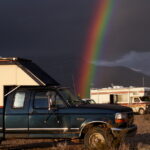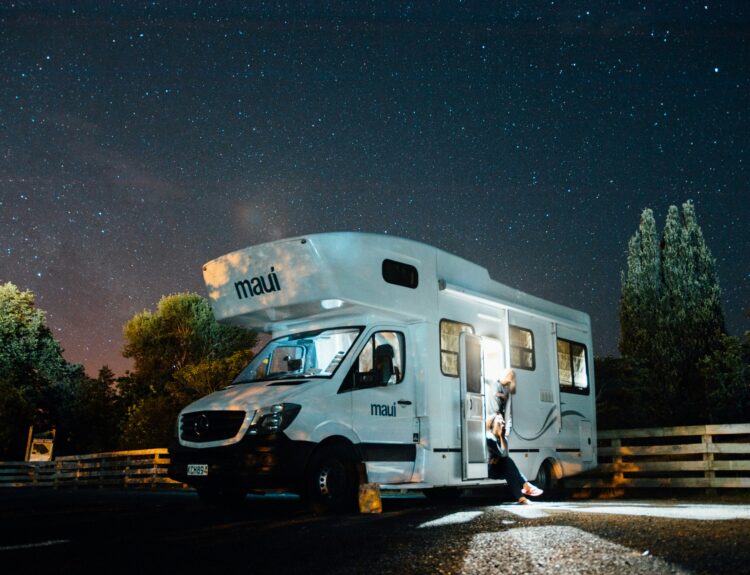This is a guest post by blogger Mark Johnson, creator of Box Canyon Blog.
On the road, somewhere in a God forsaken, scrub-brushed, Land of DisEnchantment: “Of the deserts I know, this barren quarter of the Colorado Plateau is the most unfortunate.” Craig Childs, House of Rain.
Suddenly, the last week in March was upon us. It seemed as if Old Man Winter had given up… packed his bags of cold and snow and beat and early retreat. My wife, Bobbie, and I were winding down another RV sojourn amongst the isolated cliffs and crags of the Chiricahua Mountains, way, way down in the southeast corner of Arid-zona. After three long months on the road following the sun, we heard that the snow around our mountain hometown of Lovely Ouray, Colorado (“Switzerland of America”), was all but gone. The time was “ripe” (literally) to get out of “Goldie Box” our decrepit old Class C motorhome. She’s about the size of a modest walk-in closet, but it beats living out of a tent.
My wife, Bobbie, and I had turned in early after a long day on the trail. Outside, amidst a maze of improbably balanced, anthropomorphic boulders, an owl hooted at a waxing moon, while we exchanged volleys of verbal badminton in an attempt to shake up our routine… smashing the old idea “birdie” back and forth over a net that sagged with possibilities. It was decided to throw a stick in the spokes of tradition, to trade the usual spring explorations of cliff dwellings on Utah’s Cedar Mesa for the unknown funk, rust, and ruins of northern New Mexico. Bobbie thumbed a Gazetteer. From our current camp in Chiricahua, we were practically within spitting distance of New Mexico. Her index finger landed on “Chaco Canyon.” “We’ve never been there,” she volleyed. Game over.
Sometimes it is a fine line that separates the worst from the best of plans. The realization that repetition had slowly, imperceptibly, eroded our winter “groove” into a rut—that adventures stuck in “replay” are no longer “adventures”—was freeing. When one begins to find comfort in dancing to the same old songs… two-stepping in circles in the same old groove like some aging horse grinding out his last days harnessed to a gristmill, it’s time to invite Miss Sara N. Dipity to the “dance” and learn some new steps, like the Chaco Cha-Cha.
To a sensible, modern observer, New Mexico’s Chaco Canyon looks and feels inhospitable… an unlikely setting for the Native American version of “Mecca.” But seeing is believing, there, far and away in the middle of nowhere, unfolded a sprawling multistoried complex of monumental proportion… expertly designed, hand-crafted, celestially aligned buildings of stone, and dating back one thousand years. Pueblo Benito, the largest compound in a 16-unit complex, boasted nearly 800 rooms and dozens of kivas, a circular place of ceremony where the spirit world below intersects the real world above. At first glance, I was dumbfounded by Chaco’s immensity, then gradually humbled by what could have only been a massive, spiritually driven, labor of love. Century upon century upon century, successive generations took up a hammer and built on.
Chaco Canyon’s enormous scale confounds the “experts.” Throughout its construction (800 to 1200 AD) the average population at any given time is estimated to have been in the neighborhood of 2000 residents, most of which dwelled in separate pit houses that surround the Chaco project. It begs the question: If not to live in, what was the purpose of all this over-build? Not until the 19th century was anything constructed that remotely approached the expertise and man-hours required to construct what now lies half buried in Chaco Canyon. Consider the improbable task, that it required 250,000 conifer logs to beam Chaco’s multiple floors and roofs. Then add to that the impossible, that every tree was felled, dried, and hand carried from mountains 70 miles distant. Humbling, indeed.
Wall construction was no less formidable. The weight of multiple stories required lower supporting walls to be as much as four to five feet in width. Thankfully, a million years worth of eroded canyon walls supplied abundant material. The supporting wall’s core is more function over form… a cobble of random rocks fused with mud. Not till I closely examined areas of disintegration that exposed the inner wall’s methodology could I fully appreciate the staggering volume of material, labor, and time required for construct. Then add to the walls core a horizontal run of masonry veneer—expertly laid stone, nothing short of a mosaic masterpiece—thousands upon thousands of lineal feet, and as many as four stories in height. The painstakingly laborious and physical attributes of this monumental undertaking—great as they were—are surpassed by attributes of artistic delicacy and attention to detail. It is no exaggeration that the veneer alone required hundreds of millions of hand-selected stones—ranging in size from Communion wafer to shoebox—each mortared with pride and in perfect solstice alignment. And this, with the crudest of stone age tools, a plumb-bob, and patience. God Almighty.
At its apex in the 11th century, Chaco was the ceremonial and cultural hub of the entire southwest… unprecedented in spectacle, “a place in time when a civilization danced across this desert like rain,” as Craig Childs expressed with such verbal-to-visual eloquence. Roads straight as wheel spokes and still visible today from space, radiate from Chaco’s hub. Where canyons and cliffs got in the way, these pragmatic Native Americans simply carved staircases into stone walls and maintained the line.
In a sense, Chaco becomes the original “Trading Post.” Archeologists have unearthed non-indigenous goods—brightly feathered tropical Macaws, seashells, unique pottery, and various precious stones—evidence that commerce took place from as far away as Central America. Remote, arid, wind-blown, barren, desolate—inhospitable—Chaco Canyon somehow became a crossroads for culture, commerce, and, perhaps most importantly, the exchange of ideas.
No amount of digging through layers of time or sifting through “garbage” or digging up graves can reveal all the secrets of lost civilizations. We don’t know why, for instance, after well over 300 years of hard labor under brutal sun and in biting wind, Chaco was suddenly set afire and abandoned… valuables and personal possessions left behind as if in haste. Could have been war, drought, famine, disease, or dwindling resources. Being a lifelong peripatetic, I’d like to think that it was just time to go—that some long-dormant hunter-gatherer gene was suddenly resuscitated, that it was time to once again “dance across the desert like rain,” and that ultimately—one grey, wind-blown dawn, as the sun rose from the land of spirits—an all-powerful shaman bellowed from the bowels of a Kiva at the top of his lungs, “Enough.”
Dance Grasshoppers. “Dance across the desert like rain.”





